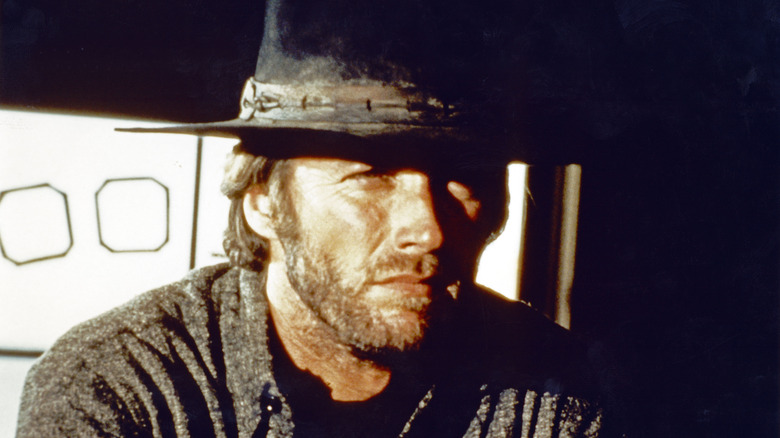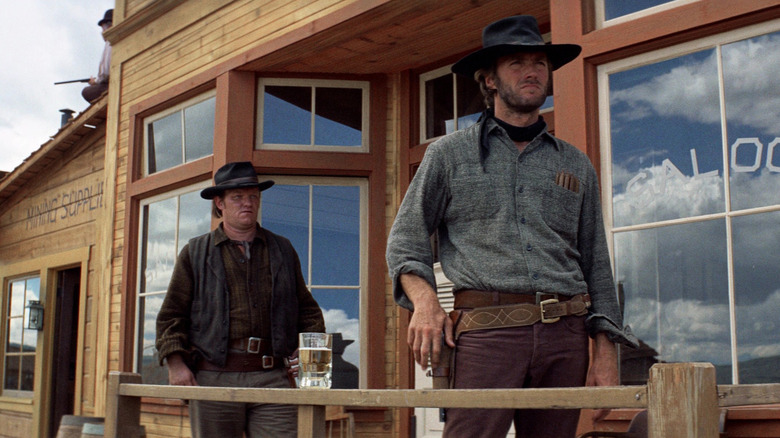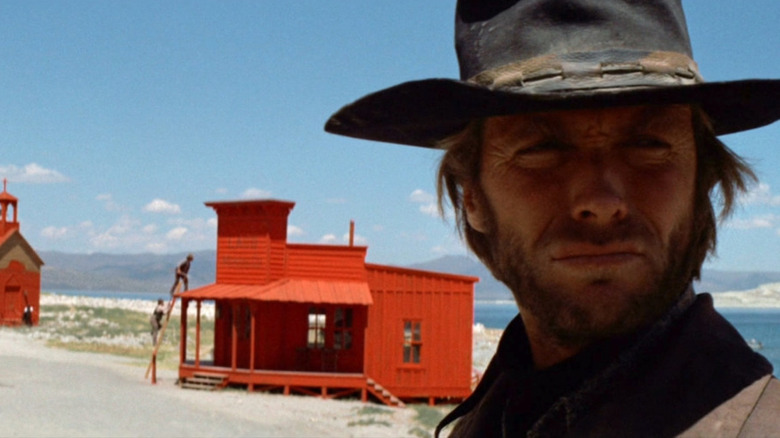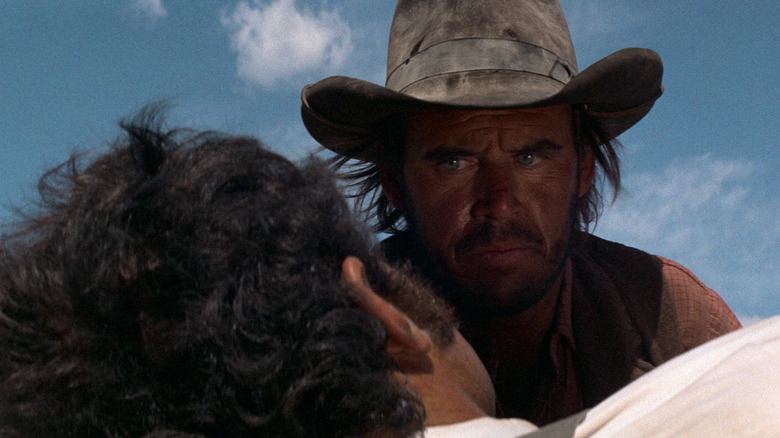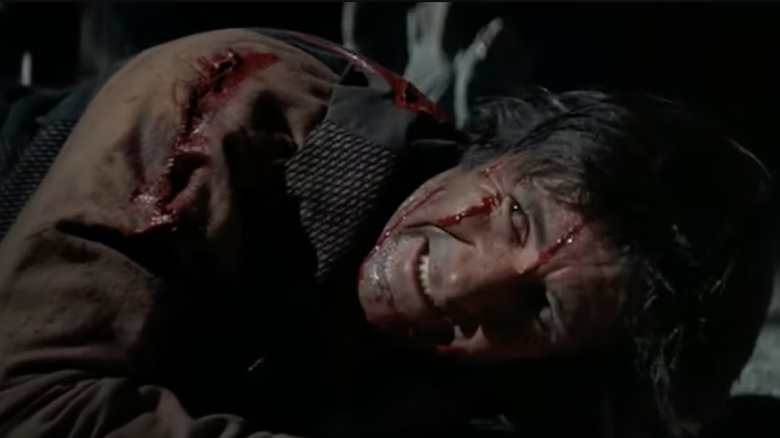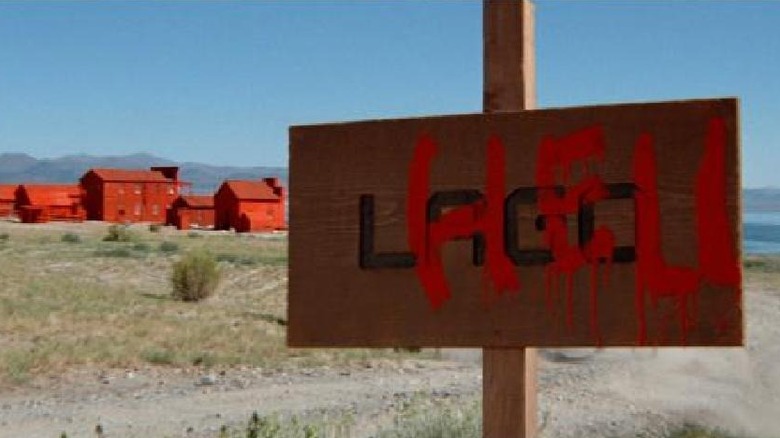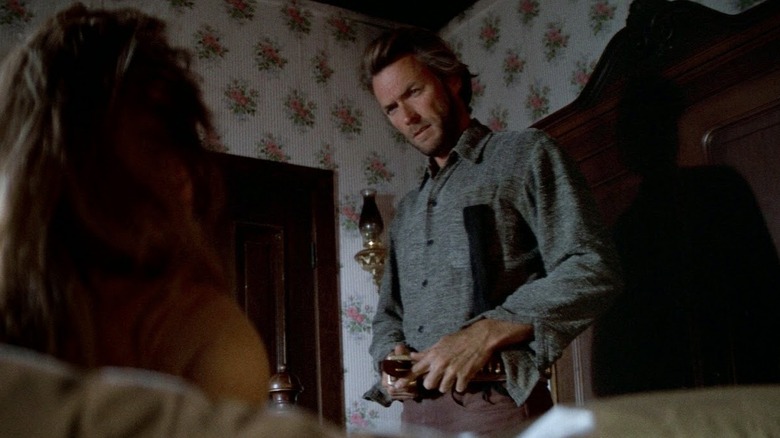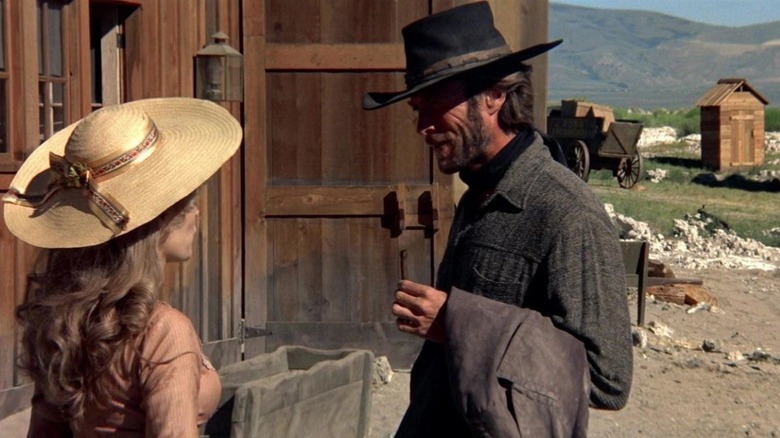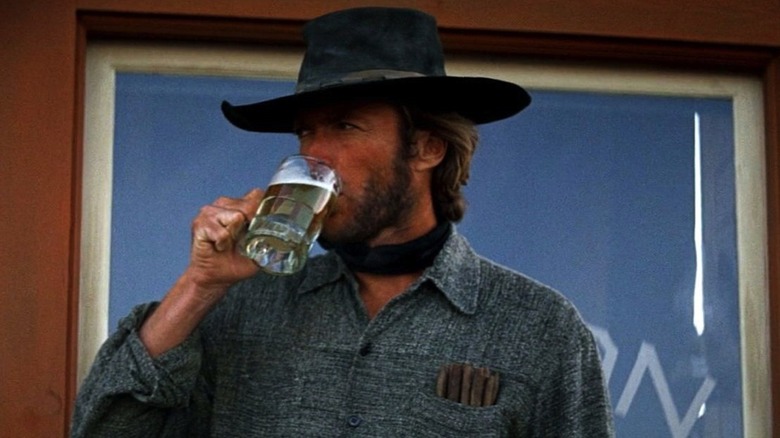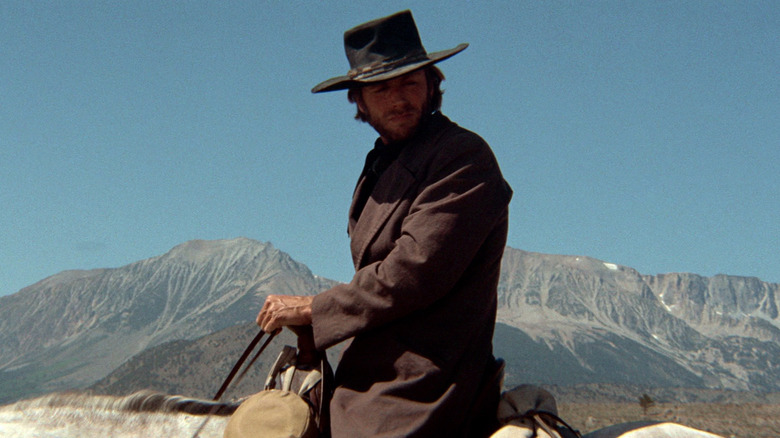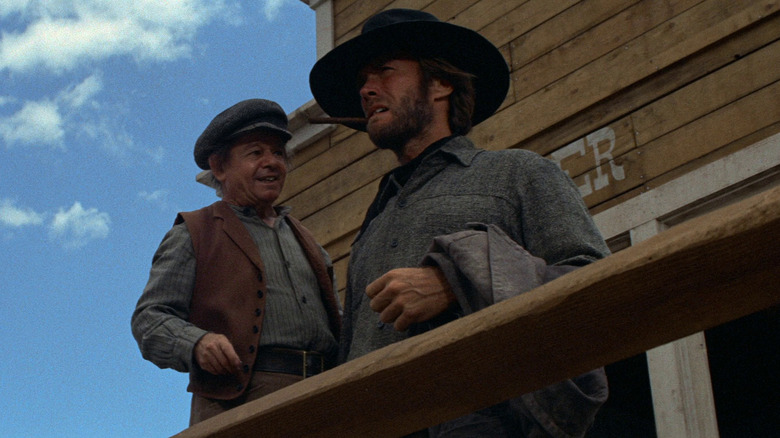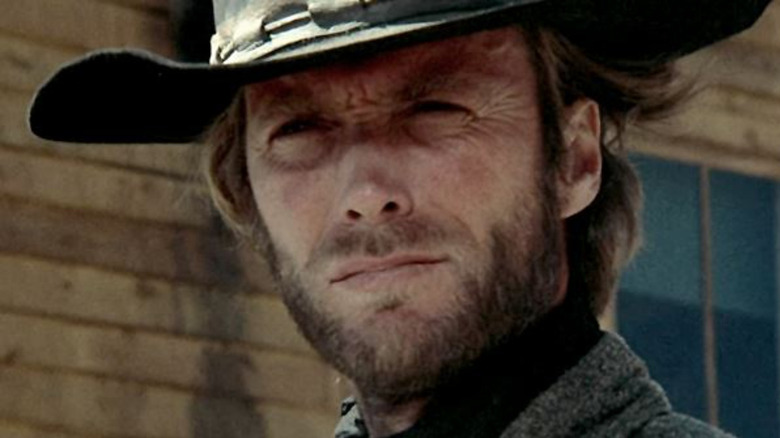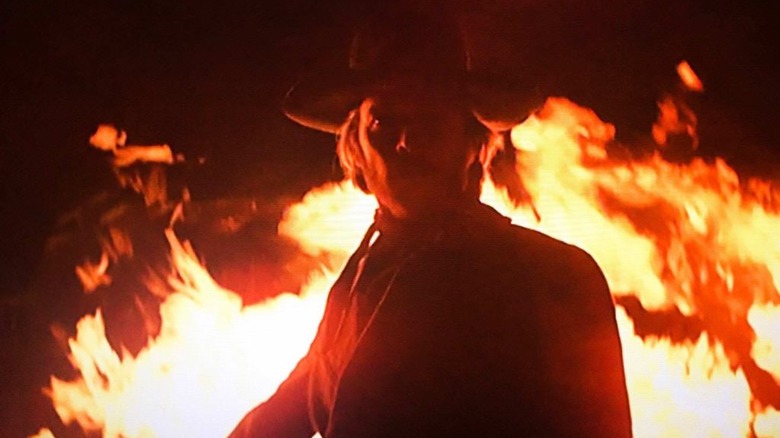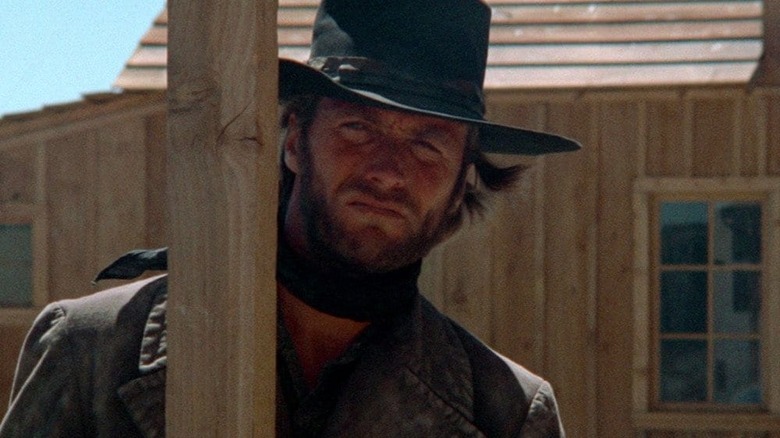The Ending Of High Plains Drifter Explained
Clint Eastwood rose to superstardom thanks to a series of mid-'60s Western classics, including "A Fistful of Dollars," "For a Few Dollars More," and "The Good, the Bad, and the Ugly," three films collectively known as the "Dollars Trilogy." Eastwood continued to dominate the Western genre after that, and when he became a director years later, he helmed several more, including the four-time Academy Award-winning "Unforgiven" in 1992.
When Eastwood was just starting out as a director, however, the first Western he directed was 1973's "High Plains Drifter," a movie that put a new twist on the trope of the shadowy gunslinger. Acclaimed for its genre-breaking story and subversive elements, "High Plains Drifter" quickly became a classic itself, and helped establish Eastwood as a director as skilled as he was an actor. The story sees a man credited only as The Stranger (Eastwood) entering the town of Lago and being hired to protect its citizens from a band of vicious outlaws.
The story may sound stereotypical, but "High Plains Drifter" is anything but ordinary. Its ending specifically is perhaps the most unique conclusion for a '70s Western, with plot twists and mystifying reveals that turn the story on its head. Even if you saw it years ago, your own head still might be spinning, so we're here to explain the ending of "High Plains Drifter."
What you need to remember about the plot of High Plains Drifter
A mysterious gunslinger rides into the small border town of Lago and immediately causes trouble, murdering three men who harass him in a saloon. He then rapes a young woman named Callie (Marianna Hill), proof that he is a cruel, cold-hearted man. During his first night in town, the Stranger has a dream of a man, later revealed to be federal Marshal Jim Duncan (Buddy Van Horn), being whipped to death while the people of Lago watch and do nothing.
The townspeople soon recognize, however, that the Stranger's ruthlessness can be used to their benefit: They ask him to help protect the town from three outlaws who they once put in prison, but who are getting out and may be on their way to Lago for revenge. The Stranger reluctantly agrees but demands that in return for helping them, he wants free reign to take whatever he pleases — from whiskey to women — while naming a dwarf named Mordecai (Billy Curtis) as the town's new sheriff. The townspeople are hesitant but happy with the deal at first. But when the Stranger goes too far, a group of townspeople try to have him killed, resulting in the destruction of the town's hotel.
Despite the attack, the Stranger keeps his end of the bargain and even teaches the townspeople how to shoot. He also strangely requests that they paint every building in the town bright red as they await the arrival of the vengeful outlaws.
What happens at the end of High Plains Drifter
Once the townspeople paint the town red, the Stranger leaves Lago in pursuit of the outlaws. He doesn't try to kill them, though, instead provoking them into attacking the town. When they do, the Stranger's training turns out to be for nothing, because the denizens of Lago show that they are cowardly, weak, and incompetent, and the outlaws have no trouble in striking down their attackers and burning down much of the town. The outlaws then gather the survivors in the saloon and threaten to slaughter them when the Stranger finally shows himself, ambushing one of the outlaws.
Standing in front of crackling flames, the Stranger whips the man to death — killing him the same way that Duncan was murdered. The other two outlaws try to outmaneuver him, but it's no use: the Stranger uses a whip to hang the first one and shoots the last criminal dead in a quick-draw duel in the street. With their pursuers killed, town leader and hotel owner Lewis Belding (Ted Hartley) attempts to kill the Stranger, but is shot down himself by Mordecai.
As the dust settles over Lago, the Stranger prepares to leave town. Before he does, he watches as Mordecai buries the dead, while also erecting a tombstone over the grave of Marshal Duncan. When Mordecai tells the Stranger that he doesn't even know his name, the Stranger replies, "Yes you do," and vanishes into the desert.
What does the ending of High Plains Drifter mean?
During the course of the film, the death of Marshal Jim Duncan — the man that the Stranger had mysteriously dreamed of — becomes central to the story. Duncan is killed by the same three outlaws who later want revenge on the town, all while the townspeople do nothing to stop it. Throughout the movie, we learn that it's not the Stranger who is truly the cruel one (as awful as he is), but the townspeople themselves.
Not only did the people callously allow Duncan to be killed, but their greed and corruption comes to light, too. More than once we're told in no uncertain terms that the people of Lago are gutless, cowardly, and lacking moral fortitude. They won't stand up for justice, and worse, are corrupt. Even the preacher (Robert Donner) shows himself to be vicious, as he charges displaced families to allow them to sleep in his church when the Stranger forces them out of the town hotel.
In the end, "High Plains Drifter" holds a message about moral decay in the modern world, and the rampant exploitation of others for personal gain. The Stranger represents real justice — not of the law, but of moral conscience, punishing the townspeople for their misdeeds.
What really happened to Marshal Jim Duncan?
We first learn of Marshal Jim Duncan through the Stranger's dream, but later we discover more about who he was and what happened to him. The biggest revelation comes late in the film, when we learn that Duncan had discovered that the town's mining operations were illegal and operating on federal land.
Knowing that if Duncan informs on them, the town would lose its biggest source of money, the leaders of Lago decide to have him killed, and hire three outlaws to do. Afterward, they dump Duncan's body in a shallow grave, without even putting up a headstone.
To cover for their crimes, they also frame the outlaws for a gold heist, getting them sent away to prison. Now, with their release, the townspeople fear their crime is going to come back to haunt them. So when the Stranger comes into town, they are willing to do just about anything to get him to stop the outlaws. Little do they know that they've put their trust in the very last man they should.
Why does the Stranger want the town painted red?
When the Stranger is hired to protect the people of Lago, he goes about it in some strange ways. Though he does attempt to train them in gunfighting, and helps them plan an ambush of the outlaws, some of his other instructions seem perplexing, both to the people and to the audience. Late in the story, the Stranger tells them to paint every building in town red, and asks them to assemble a large outdoor picnic complete with food and drinks. He even has them hang a banner at the edge of town, stating "Welcome Home Boys." But what's the purpose of this strange plan?
It's true that "painting the town red" is a common maxim that means to party hard or have a wild night out. But the Stranger's orders to literally paint the town red have another meaning. It all goes back to Marshal Jim Duncan, who with his dying breath gazed into the eyes of the onlookers and told them, "Damn you all to hell."
If this meaning seems coincidental, consider that when the preacher asks if the church should be painted, the Stranger replies, "Especially the church." Then, when the paint job is complete, someone — presumably the Stranger — scrawls "Hell" over the sign marked "Lago" at the entrance to town. Not only has the Stranger damned the townspeople by getting them all killed, he's turned the site of their slaughter into hell itself.
Who is the mysterious Stranger?
When the Stranger first rides into town, he's a nameless, ghostly figure who speaks few words, but is capable of the most vile acts one could imagine. But who is he and why is he in Lago? At first we are left to assume that he is just what the title suggests, a drifter who finds himself in Lago by chance. But that's not the truth, because by the end of the film, we realize he's no ordinary man at all — he's the ghost of Marshal Jim Duncan.
We get hints of his otherworldly nature early in the movie, when the woman he rapes seeks revenge, shooting him point blank several times while he reclines in a bathtub. The Stranger emerges from the water unharmed, without a scratch or bullet wound to be seen. But the biggest evidence comes when Sarah Belding (Verna Bloom) tells him the story of Duncan, and how the people didn't bury him with a tombstone. She tells the Stranger that one's soul cannot rest without one.
At the end of the film, we get more direct clues to the Stranger's identity. When Mordecai is putting up a tombstone in the final scene, and the Stranger says that Mordecai knows his name, the camera pans directly to the stone, revealing Duncan's name. This implies not only that the Stranger is indeed the ghost of Duncan, but that he can now finally rest in peace, as he rides off into the plains.
What has Clint Eastwood said about the ending of High Plains Drifter?
The ending of "High Plains Drifter" isn't the typical conclusion to a Western. The supernatural twist was something new for the genre, and while it might have rubbed some audiences (who wanted a more traditional Western) the wrong way, there's no denying that it's one of the most distinctive Westerns of its day. As for the meaning behind the film, star and director Clint Eastwood has had a lot to say over the years, defending the more philosophical nature of the film.
Following an attack on the movie by Western superstar John Wayne, Eastwood said, in a quote published in the 2015 book "The Clint Eastwood Westerns," that the ending wasn't meant to be taken quite so literally. "[It's] really just an allegory," said Eastwood. "A speculation on what happens when they go ahead and kill the [Marshal] and somebody comes back and calls the town's conscience to bear." Eastwood added that the film's lesson is simple: "There's always retribution for your deeds."
Fans have their own theories about the ending of High Plains Drifter
The ending of "High Plains Drifter" lays bare the secret behind the Stranger's identity, but there's still plenty of room for interpretation of other elements of the film. A lesson on moral cowardice and the fight for justice, it can be seen in many different ways. At the time it was released, however, many were upset by the fact that its apparent hero, The Stranger, was a cold-blooded murderer with seemingly no moral compass himself. Some fans believe there was a reason for that.
On Reddit, one user suggested that the film's mean-spirited nature was intended to teach the audience a lesson. As the townspeople, and The Stranger himself, commit hideous acts of cruelty, it can be seen as a challenge to the audience. "I almost wonder if the point of the movie being as harsh and cruel as it is, is to get the viewer to do what the townspeople would not and stop the violence from happening," said u/pizmeyre. The Redditor considered that perhaps the intent was to force the viewers to "feel so bad that they feel the need to overcome complacency and actually make a difference rather than being a passive observer."
The true story that inspired High Plains Drifter
"High Plains Drifter" is an original screenplay, not based on any real-life Western tale or classic novel. But writer Ernest Tidyman says the film was heavily inspired by a true story, though ironically it was one that took place nearly 100 years after the film was set. It was in 1962, some 10 years before the film was produced, that a young woman named Kitty Genovese was murdered on the street in Queens, New York. Reports claimed that gawking onlookers and witnesses heard her cries for help but took no action.
The incident wasn't just a horrific crime, it was also the origin of the psychological condition known as "The Bystander Effect," which Psychology Today described as "when the presence of others discourages an individual from intervening in an emergency situation, against a bully, or during an assault or other crime." The story of Genovese didn't lead to violent retribution, but it did make Tidyman wonder what would happen if it did. In the film version of a similar event, the ghost of the victim returns and gives the onlookers their comeuppance.
Why did the Stranger trust Mordecai?
In "High Plains Drifter," actor Billy Curtis (best known for portraying the Munchkin city father in "The Wizard of Oz") plays a dwarf named Mordecai. He's the only one to seem friendly towards the Stranger when he comes to Lago, impressed by his prowess with a pistol and almost eager to be his friend. So when the Stranger makes a deal with the town and is put in charge, his first order of business is to make Mordecai the new town sheriff. One might think it's because of the friendly reception the Stranger receives from him, but that may not be the whole story.
In flashbacks sprinkled throughout the film, we're given glimpses of the death of Marshal Duncan. While Mordecai doesn't intervene, he hides himself under a building and watches in horror at Duncan's death. Because he is one of just two people who seemed to want to put a stop to Duncan's murder (the other being Sarah Belding), it makes sense that he'd trust Mordecai as well as Sarah. The fact that Mordecai is also, like Duncan, mistreated by the town also makes them kindred spirits of a sort.
Is there any connection between the Stranger and the Man with No Name?
"High Plains Drifter" stars Clint Eastwood as a steely-eyed gunslinger who talks little but metes out his own brand of Western justice and violence. He grinds a cigarillo between his teeth and squints at passers-by with a subtle mistrust, and he's never afraid to use his six-shooter to fatal effect. Given that description, one might think we were talking about Eastwood's character from the "Dollars" trilogy.
Known only as "The Man with No Name," Eastwood's character indeed has a lot in common with the Stranger from "High Plains Drifter," and its fair to wonder if they are connected, either thematically or narratively. Though "High Plains Drifter" was likely inspired tonally by Leone's films, the two characters are definitely not the same man. Yet they share enough in common that it's hard to not see it as a coincidence. Plus, with Eastwood playing both classic characters, it's likely they are two sides of the same coin.
How the ending of High Plains Drifter subverts the traditional Western
When "High Plains Drifter" came out in 1973, it caused quite a stir among some Western movie aficionados. Most famously, it riled up movie star John Wayne, who objected to its depiction of the American frontier. According to Eastwood, Wayne actually wrote to him to voice his displeasure. "He said it wasn't really about the people who pioneered the West," Eastwood said of the letter (via the Telegraph). "I realized that there's two different generations, and he wouldn't understand what I was doing."
Despite Wayne's stance being in contrast to the film's critical acclaim and its eventual legacy as one of the best Westerns of its day, the "True Grit" star wasn't wrong. But "High Plains Drifter" was never meant to be about settling the West. As one of the best examples of a revisionist Western, the movie is a less romantic take on the Old West, with more complex, realistic characters.
In "High Plains Drifter," Eastwood doesn't portray the hopeful, peaceful pioneers of movies past, instead opting to portray a town of cruel, greedy, and corrupt people. The Stranger isn't good or evil, he's an otherworldly specter dishing out punishment — not justice. It's a far cry from those John Wayne classics where the hero saves the day, rescues the innocent, and rides off for another adventure.
How the ending of High Plains Drifter changed
The ending of "High Plains Drifter" might be one of the most unique in the Western genre. It ends with a touch of the supernatural, as we learn that the Stranger is almost certainly the ghost of Marshal Duncan. It probably came as something of a stunner for Western fans, who were used to more standard resolutions to tales of the frontier, but it's since become the film's defining element. Believe it or not, however, it almost didn't happen.
Back in 1980, Clint Eastwood explained that in this original script, the Stranger wasn't the ghost of Jim Duncan at all. Instead, he was Duncan's brother, out for vengeance against the town that killed his sibling. "To me, if the [Stranger] comes to town and immediately says, 'I'm the brother of the murdered sheriff,' right away you draw the conclusions," Eastwood said about changing the script.
By taking out that aspect of the story, but still having the Stranger dream of the sheriff being whipped to death, Eastwood made the character's motives more enigmatic. "You know from there that he's tied in some way, but you're not sure how," he said. "Once he takes the town and humiliates them through his own methods, you're asking, 'Who is he? Why is he doing this?' That one change made "High Plains Drifter" into an all-time classic.
